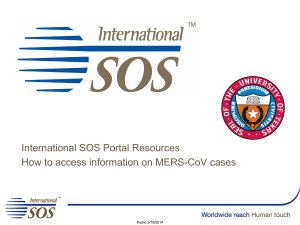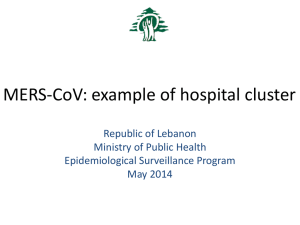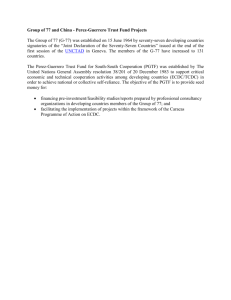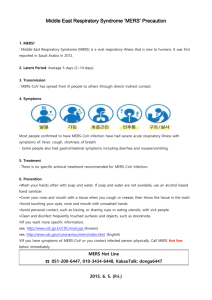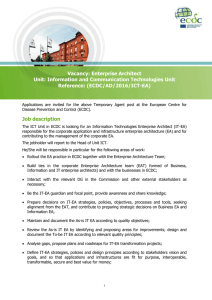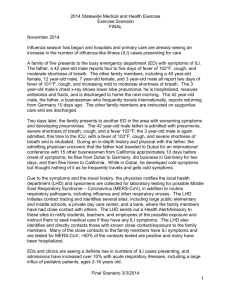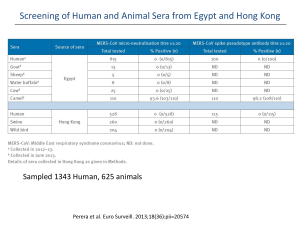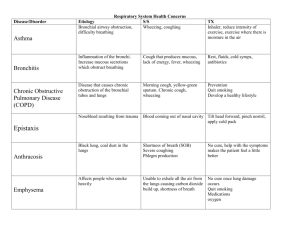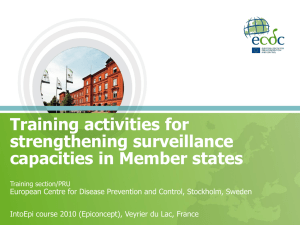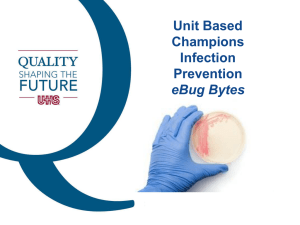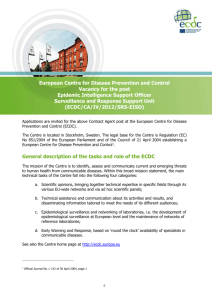The epidemiology
advertisement
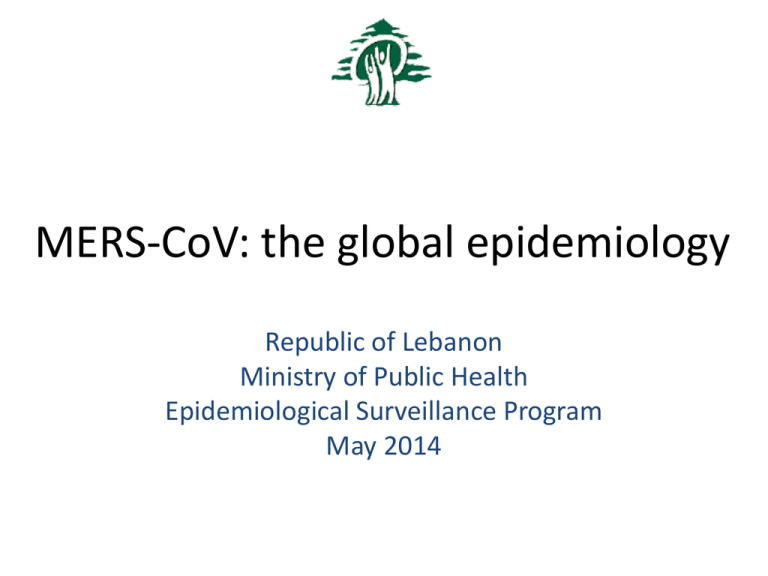
MERS-CoV: the global epidemiology Republic of Lebanon Ministry of Public Health Epidemiological Surveillance Program May 2014 Sources • • • • WHO: www.who.int CDC: www.cdc.gov ECDC: www.ecdc.europa.eu world map: http://coronamap.com/ Outline • • • • • Total count By time By place By person Travel advice Total count • Since April 2012 to 08 May 2014 – 536 laboratory-confirmed cases of MERS-CoV – including 145 deaths • To date, the affected countries – Middle East; Jordan, Kuwait, Oman, Qatar, Saudi Arabia (KSA), United Arab Emirates (UAE) and Yemen – Africa: Egypt and Tunisia – Europe: France, Germany, Greece, Italy and the United Kingdom – Asia: Malaysia and Philippines – North America: the United States of America (USA). • All of the cases recently reported outside the Middle East recently travelled from countries inside of the Middle East (KSA or UAE). Source: WHO Time: Epidemic Curves Confirmed cases by country of presumed exposure Source: WHO Time: Epidemic Curves Confirmed cases by outcome Source: WHO Time: Epidemic Curves Epidemic Curve by Case-Type (Primary vs. Secondary) Source: WHO Place: of onset (up to 16May 2014) Source: ECDC Place: of onset (up to 16May 2014) Source: ECDC Place: place of exposure Cases by country of probable exposure Source: WHO Place: place of exposure Source: WHO Place: place of exposure Source: ECDC Place: World map Source: http://coronamap.com Person • Gender: 66% of cases are male • Median age is 49 years old (range 9 months94 years old) • Primary < secondary cases Person Source: ECDC Person Characteristics of primary vs secondary cases* *Table includes cases with reported information on each variable; 234 cases have missing information about case type Primary Cases Secondary Cases 98 204 57.5 (2-90) 39 (9m-94) % of male cases 80% (78/97) 56% (111/198) % of cases with ≥1 underlying condition reported 84% (74/88) 69% (66/96) % of cases classified as fatal 83% (48/58) 45% (33/74) % Severe 91% (88/97) 27% (53/198) % Asymptomatic 0 5% (2/41) 33% (23/70) 42% (84/198) 63% (93/147) 9% (3/32) Characteristic n Median age in years (range) % Health care workers % reported contact with camels Source: WHO WHO Travel Advice 1 • At this time, the risk to an individual pilgrim of contracting MERS-CoV is considered very low. • WHO does not recommend the application of any travel or trade restrictions or entry screening. • Before departure, pilgrims should be advised: – Pre-existing major medical conditions can increase the likelihood of illness, including MERS-CoV infection, during travel – Pilgrims should consult a health care provider to review the risk and assess whether making the pilgrimage is advisable WHO Travel Advice 2 • Dissemination of general travel health precautions, which will lower the risk of infection in general. • Specific emphasis should be placed on: – Washing hands often with soap and water , or with hand rub – Adhering to good food-safety practices (avoiding undercooked meat or food prepared under unsanitary conditions, and properly washing fruits and vegetables before eating them) – Maintaining good personal hygiene – Avoiding unnecessary contact with farm, domestic, and wild animals WHO Travel Advice 3 • Travelers who develop a significant ARI with fever and cough (severe enough to interfere with usual daily activities) should be advised to: – Minimize their contact with others – Adopt cough etiquette: Cover their mouth and nose with a tissue when coughing or sneezing and discard the tissue in the trash after use and wash hands afterwards, or, if this is not possible, to cough or sneeze into upper sleeves of their clothing, but not their hands – Report to the medical staff WHO Travel Advice 4 • Patients: – Returning pilgrims developing a significant ARI with fever and cough during the two weeks after their return should seek medical attention. – Persons who have had close contact with a pilgrim or traveler with a significant ARI with fever and cough and who themselves develop such an illness should seek medical attention. • Clinicians: – Practitioners and facilities should be alerted to the possibility of MERS-CoV infection in returning pilgrims with ARI, especially those with fever and cough and pulmonary parenchymal disease – If clinical presentation suggests the diagnosis of MERS-CoV, laboratory testing, should be done and infection prevention and control measures implemented.
